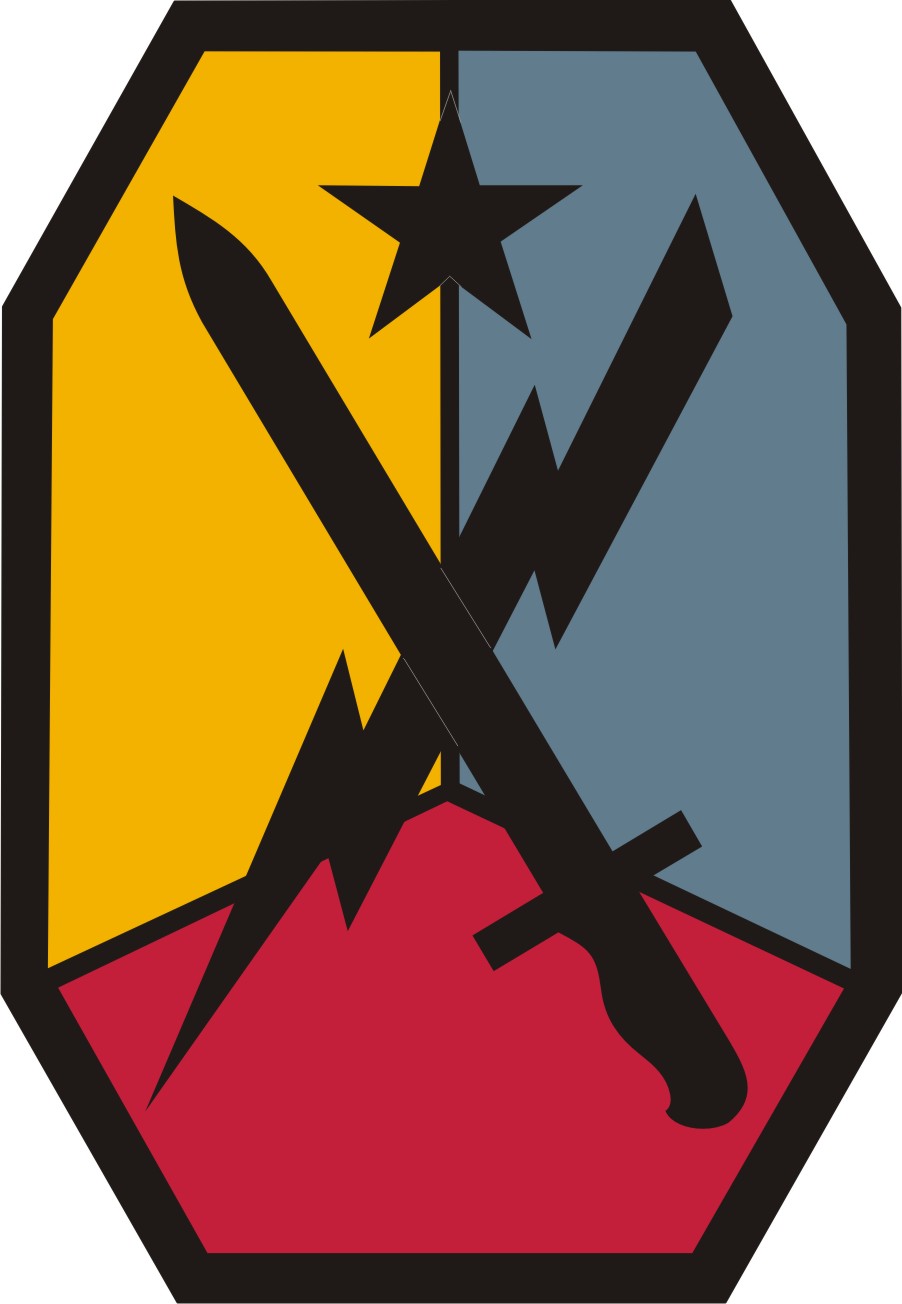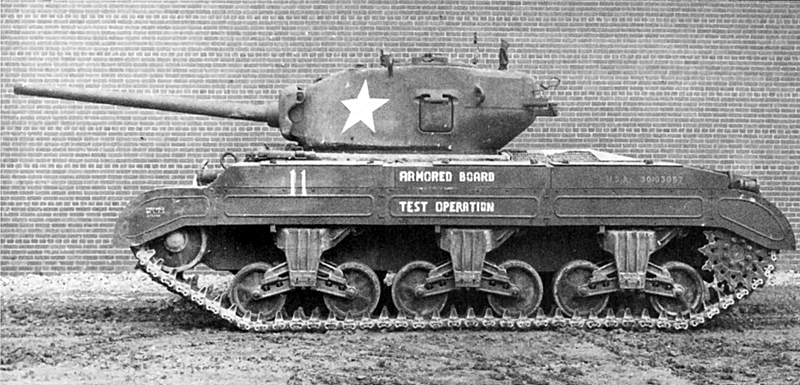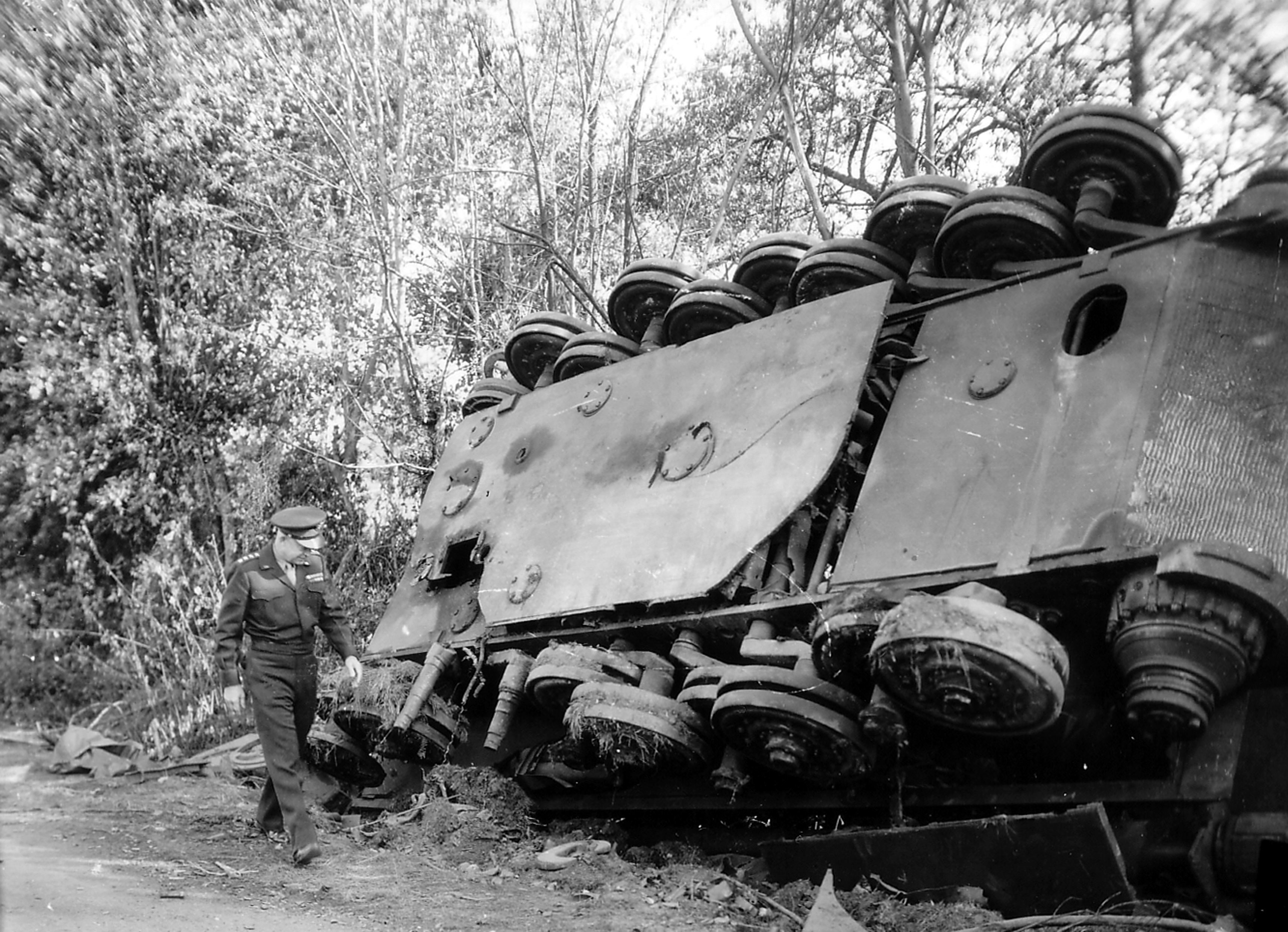|
T34 Heavy Tank
The T34 Heavy Tank was an American design for a heavy tank. It evolved from the T29 Heavy Tank and T30 Heavy Tank in 1945, using the same chassis, but sporting a modified 120 mm Gun M1 anti-aircraft gun. Extra armor plating was applied to the rear of the turret bustle as a counterweight for the heavier 120mm T53 main gun. No production orders were placed for the T34, which was felt to be too heavy. Development In 1945, encounters with German heavy tanks and tank destroyers such as the Tiger II and Jagdtiger led to a new project to create a vehicle that could counter these new threats. The result were the T29, armed with a 105mm gun, and the T30 armed with a 155mm gun. Both were built around a lengthened version of the T26E3 chassis., and apart from the different use of guns and engines, they were originally almost identical. Early in 1945 the Ordnance Department began work on turning the 120mm anti-aircraft gun into a tank gun. It soon became clear that this gun would have ... [...More Info...] [...Related Items...] OR: [Wikipedia] [Google] [Baidu] |
Aberdeen Proving Ground
Aberdeen Proving Ground (APG) (sometimes erroneously called Aberdeen Proving ''Grounds'') is a U.S. Army facility located adjacent to Aberdeen, Harford County, Maryland, United States. More than 7,500 civilians and 5,000 military personnel work at APG.There are 11 major commands among the tenant units, including: * United States Army Communications-Electronics Command (CECOM) * United States Army Combat Capabilities Development Command (CCDC) * United States Army Test and Evaluation Command (ATEC) * Edgewood Arsenal * Adelphi Laboratory Center **The Army Reserve Information Operations Command **Unified Cross Domain Services Management Office **HQ, U.S. Army Contracting Command (Army Contracting Command –APG, Adelphi Contracting Division) **U.S Army 93rd Signal Network - Network Enterprise Center **Logistics Readiness Center **U.S. Army Cyber Operation Group – 335th Signal Command **Blossom Point Research Facility History APG is the U.S. Army's oldest active proving ground, est ... [...More Info...] [...Related Items...] OR: [Wikipedia] [Google] [Baidu] |
Heavy Tank
Heavy tank is a term used to define a class of tanks produced from World War I through the end of the Cold War. These tanks generally sacrificed mobility and maneuverability for better armour protection and equal or greater firepower than tanks of lighter classes. Role Heavy tanks achieved their greatest, albeit limited, success when fighting lighter tanks and destroying fortifications. Heavy tanks often saw limited combat in their intended roles, instead becoming mobile pillboxes or defensive positions, such as the German Tiger designs, or the Russian KV designs Design Heavy tanks feature very heavy armor and weapons relative to lighter tanks. Many heavy tanks shared components from lighter tanks. For example, the M103 heavy tank shared many components with lighter Patton tanks, including transmission and engine. As a result, they tend to be either underpowered and comparatively slow, or have engine and drive train reliability issues. In case of an entirely new design deve ... [...More Info...] [...Related Items...] OR: [Wikipedia] [Google] [Baidu] |
Heavy Tanks Of The United States
Heavy may refer to: Measures * Heavy (aeronautics), a term used by pilots and air traffic controllers to refer to aircraft capable of 300,000 lbs or more takeoff weight * Heavy, a characterization of objects with substantial weight * Heavy, a type of strength of Scottish beer * Heavy reader, a reader of 21 or more books per year, according to the Pew Internet and American Life Project report, "The Rise of E-Reading" (2012) Arts, entertainment, and media Music Groups * The Heavy (band), a rock band from England Albums * ''Heavy'' (Heavy D album), 1999 * ''Heavy'' (Iron Butterfly album), a 1968 album by Iron Butterfly * ''Heavy'' (Bin-Jip album), the second studio album by Bin-Jip Songs * "Heavy" (Collective Soul song), 1999 * "Heavy" (Lauri Ylönen song), 2011 * "Heavy" (Linkin Park song), 2017 * "Heavy" (Anne-Marie song), 2017 * "Heavy", by Cxloe, 2020 * "Heavy", by Flight Facilities featuring Your Smith, 2021 * "Heavy", by Peach PRC, 2021 Television * ''Heavy'' ... [...More Info...] [...Related Items...] OR: [Wikipedia] [Google] [Baidu] |
Fort Benning, Georgia
Fort Benning is a United States Army post near Columbus, Georgia, adjacent to the Alabama–Georgia (U.S. state), Georgia border. Fort Benning supports more than 120,000 active-duty military, family members, reserve component soldiers, retirees and civilian employees on a daily basis. It is a power projection platform, and possesses the capability to deploy combat-ready forces by air, rail, and highway. Fort Benning is the home of the United States Army Maneuver Center of Excellence, the United States Army Armor School, United States Army Infantry School, the Western Hemisphere Institute for Security Cooperation (formerly known as the School of the Americas), elements of the 75th Ranger Regiment, the 1st Security Force Assistance Brigade, and other tenant units. It is named after Henry L. Benning, a brigadier general in the Confederate States Army during the American Civil War, Civil War. Fort Benning is one of List of U.S. Army installations named for Confederate soldiers, ten U ... [...More Info...] [...Related Items...] OR: [Wikipedia] [Google] [Baidu] |
M103 (heavy Tank)
The M103 Heavy Tank (officially designated 120mm Gun Combat Tank M103, initially T43) was a heavy tank that served in the United States Army and the United States Marine Corps during the Cold War. Introduced in 1957, it served through 1974, by which time evolution of the concept of a main battle tank had rendered heavy tanks obsolete. Design and development In December 1950 the U.S. Army made blueprints for a heavy tank reference design. In January 1951 it awarded Chrysler a $99 million contract to produce the tank. Chrysler tasked Robert T. Keller, the son of Chrysler Board Chairman K.T. Keller, with overseeing its design, and construction at the company's new Newark, Delaware, tank plant. The first T43 pilot model was completed in November 1951. Officials said the tank would "out-slug any land-fighting machine ever built." Like the contemporary British Conqueror, the M103 was designed to counter Soviet heavy tanks, such as the later IS-series tanks or the T-10 if conf ... [...More Info...] [...Related Items...] OR: [Wikipedia] [Google] [Baidu] |
M26 Pershing
The M26 Pershing was a heavy tank/ medium tank of the United States Army. It was used in the last months of World War II during the Invasion of Germany and extensively during the Korean War. The tank was named after General of the Armies John J. Pershing, who led the American Expeditionary Force in Europe in World War I. The M26 was intended as a replacement of the M4 Sherman, but a prolonged development period meant that only a small number saw combat in Europe. Based on the criteria of firepower, mobility, and protection, US historian R. P. Hunnicutt ranked the Pershing behind the German Tiger II heavy tank, but ahead of the Tiger I heavy and Panther medium tanks. It was withdrawn in 1951 in favor of its improved derivative, the M46 Patton, which had a more powerful and reliable engine and advanced suspension. The lineage of the M26 continued with the M47 Patton, and was reflected in the new designs of the later M48 Patton and M60 Patton. Production history Development ... [...More Info...] [...Related Items...] OR: [Wikipedia] [Google] [Baidu] |
Jagdtiger
The ''Jagdtiger'' ("Hunting Tiger"; officially designated ''Panzerjäger Tiger Ausf. B'') is a German casemate-type heavy tank destroyer (''Jagdpanzer'') of World War II. It was built upon the slightly lengthened chassis of a Tiger II. Its ordnance inventory designation was Sd.Kfz. 186. The 71-tonne ''Jagdtiger'' was the heaviest armored fighting vehicle (AFV) used operationally by any nation in WWII and the heaviest combat vehicle of any type to be produced during the conflict. it was armed with a 128 mm Pak 44 L/55 main gun which could out-range and defeat any AFV fielded by the Allied forces. It saw brief service in small numbers from late 1944 until the end of the war on both the Western and Eastern Front. Although 150 were ordered, only around 80 were produced. Due to an excessive weight and an underpowered drivetrain system, the ''Jagdtiger'' was plagued with mobility and mechanical problems. Three ''Jagdtigers'' survive in museums. Development With the success of t ... [...More Info...] [...Related Items...] OR: [Wikipedia] [Google] [Baidu] |
Tiger II
The Tiger II is a German heavy tank of the Second World War. The final official German designation was ''Panzerkampfwagen'' Tiger ''Ausf''. B,'' Panzerkampfwagen'' – abbr: ''Pz.'' or ''Pz.Kfw.'' (English: "armoured fighting vehicle"), ''Ausf.'' is abbreviation of ''Ausführung'' (English: variant). The full titles ''Panzerkampfwagen'' Tiger ''Ausf''. B and ''Panzerbefehlswagen'' Tiger ''Ausf''. B (for the command version) were used in training and maintenance manuals and in organisation and equipment tables. (Jentz and Doyle 1997). Also sometimes referred to as "Pz. VI ''Ausf'' B", not to be confused with "Pz. VI ''Ausf'' E”, which was the Tiger I. often shortened to Tiger B.Jentz and Doyle 1993, p. 16. The ordnance inventory designation was ''Sd.Kfz.'' 182. ( ''Sd.Kfz.'' 267 and 268 for command vehicles). It was known as King Tiger by Allied soldiers, and is also known under the informal name ''Königstiger'' (the German name for the Bengal tiger which translates literally a ... [...More Info...] [...Related Items...] OR: [Wikipedia] [Google] [Baidu] |
Anti-aircraft Gun
Anti-aircraft warfare, counter-air or air defence forces is the battlespace response to aerial warfare, defined by NATO as "all measures designed to nullify or reduce the effectiveness of hostile air action".AAP-6 It includes surface based, subsurface ( submarine launched), and air-based weapon systems, associated sensor systems, command and control arrangements, and passive measures (e.g. barrage balloons). It may be used to protect naval, ground, and air forces in any location. However, for most countries, the main effort has tended to be homeland defence. NATO refers to airborne air defence as counter-air and naval air defence as anti-aircraft warfare. Missile defence is an extension of air defence, as are initiatives to adapt air defence to the task of intercepting any projectile in flight. In some countries, such as Britain and Germany during the Second World War, the Soviet Union, and modern NATO and the United States, ground-based air defence and air defence aircraf ... [...More Info...] [...Related Items...] OR: [Wikipedia] [Google] [Baidu] |
120 Mm Gun M1
The 120 mm Gun M1 was the United States Army's standard super-heavy anti-aircraft gun during World War II and the Korean War, complementing the smaller and more mobile M2 90 mm gun in service. Its maximum altitude was about , which earned it the nickname ''stratosphere gun''. The M1 gun was used by the Army for air defense from 1944 to 1960. The 120 served primarily in static defensive roles, although it had been designed to be mobile. It became obsolete with the development of anti-aircraft missiles and was phased out after 1954. History The Army first worked on a 120 mm gun after the end of World War I, with a prototype being presented in 1924. The system was considered far too heavy and expensive to be useful, and the project slowed, although it was never canceled outright. In 1938, the Army reviewed its needs for newer AA systems and decided to order new systems for both the heavy and super-heavy role. The former was filled by the new M1 90 mm gun, which replaced ... [...More Info...] [...Related Items...] OR: [Wikipedia] [Google] [Baidu] |
T30 Heavy Tank
The Heavy Tank T30 was a World War II American tank project developed to counter new German tanks, such as Tiger I, Tiger II, and tank destroyers, such as the ''Jagdtiger'', or Soviet heavy tanks, such as IS-1 or IS-2. The T30 was designed at the same time as the T29 Heavy Tank. Early tanks Plans for four pilot heavy tanks were put forward in 1944; two T29 with a 105 mm gun and two T30 with a 155 mm gun. The T30 pilot models were started in April 1945 and were delivered in 1947. Apart from modifications to fit the different engine, the chassis was the same as the T29. The gun fired separate loading (shell and charge) ammunition. The loader was assisted by a spring rammer. The T30 was fitted with one of the largest guns ever used on an American tank. The high, rounded edge, turret was needed to accommodate the standing loader and large gun mount. Even then the gun could only be loaded at limited elevations. It could carry a mixed assortment of 34 T35E1 HVAP (high-vel ... [...More Info...] [...Related Items...] OR: [Wikipedia] [Google] [Baidu] |
T29 Heavy Tank
The Heavy Tank T29 was an American heavy tank project started in March 1944 to counter the appearance of the German Tiger II heavy tank. The T29 was not ready in time for the war in Europe, but it did provide post-war engineers with opportunities for applying engineering concepts to artillery and automotive components. Development The T29 was based upon a lengthened version of the T26E3 chassis and featured heavier armor, an upgraded Ford GAC engine producing 750 hp at 2,800rpm, which gave it a power to weight ratio of 11.68 hp/t, more comfortable controls for the driver, and a massive new turret incorporating the high-velocity 105 mm gun T5, which was later replaced by a more powerful 105 mm T5E1. The tank weighed approximately unloaded and combat loaded. Its maximum armor thickness was on the turret (not including the mantlet, which was thick), compared to on the German Tiger II's turret. The turret had a turret rotation of 18 degrees per second, takin ... [...More Info...] [...Related Items...] OR: [Wikipedia] [Google] [Baidu] |







